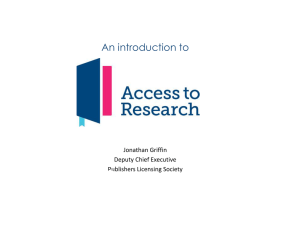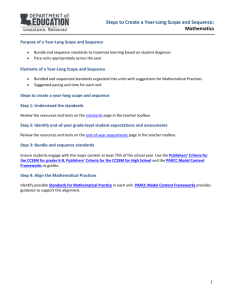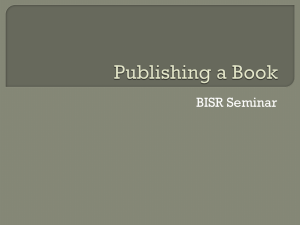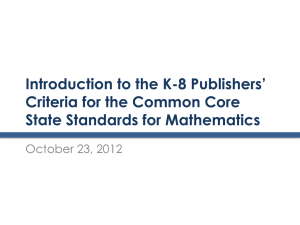Facilitator`s Guide - Illinois State Board of Education
advertisement
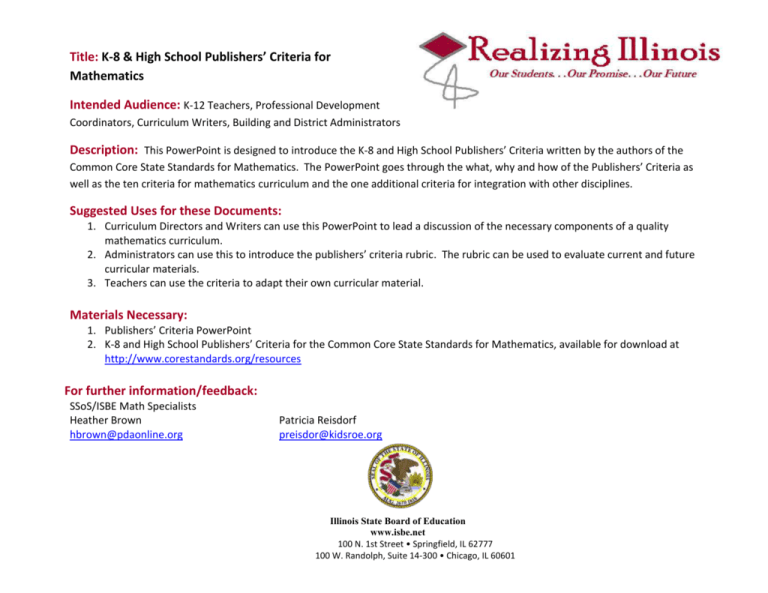
Title: K-8 & High School Publishers’ Criteria for Mathematics Intended Audience: K-12 Teachers, Professional Development Coordinators, Curriculum Writers, Building and District Administrators Description: This PowerPoint is designed to introduce the K-8 and High School Publishers’ Criteria written by the authors of the Common Core State Standards for Mathematics. The PowerPoint goes through the what, why and how of the Publishers’ Criteria as well as the ten criteria for mathematics curriculum and the one additional criteria for integration with other disciplines. Suggested Uses for these Documents: 1. Curriculum Directors and Writers can use this PowerPoint to lead a discussion of the necessary components of a quality mathematics curriculum. 2. Administrators can use this to introduce the publishers’ criteria rubric. The rubric can be used to evaluate current and future curricular materials. 3. Teachers can use the criteria to adapt their own curricular material. Materials Necessary: 1. Publishers’ Criteria PowerPoint 2. K-8 and High School Publishers’ Criteria for the Common Core State Standards for Mathematics, available for download at http://www.corestandards.org/resources For further information/feedback: SSoS/ISBE Math Specialists Heather Brown hbrown@pdaonline.org Patricia Reisdorf preisdor@kidsroe.org Illinois State Board of Education www.isbe.net 100 N. 1st Street • Springfield, IL 62777 100 W. Randolph, Suite 14-300 • Chicago, IL 60601 Facilitator’s Guide K-8 and High School Publishers’ Criteria for Mathematics PowerPoint Session Description Participants will be introduced to the K-8 and High School Publishers’ Criteria written by the authors of the Common Core State Standards for Mathematics. They will learn the ten criteria required for quality curricular material in mathematics and learn why and how to use this tool. Goal of the Session Participants will learn what the K-8 and High School Publishers’ Criteria is, why it was created and how to use it. Participants will become familiar with the criteria to evaluate curricular material for mathematics. Pre-session Preparation 1. Review the PP and slide notes, 2. Download and make copies of the K-8 and High School Publishers’ Criteria http://www.corestandards.org/resources TIME 5 min CONTENT/ACTIVITIES Introduction and Objectives Slides 1-5 Have participants try the two problems and discuss the similarities and differences. The second problem provides a greater opportunity for students to discuss mathematics and articulate a repeated reasoning. MATERIALS TIME 5 min CONTENT/ACTIVITIES What, Why and How Slides 6-9 Go through the components of each slide emphasizing these key points: The original Publishers’ Criteria was published July 20, 2012 and was created by the three lead authors of the CCSSM. It was designed to encourage faithful implementation that supported the spirit of the CCSSM. The new version was released April 2013. A high school document was also created and released in April. The tool was created to help educators focus on the components necessary in textbooks and curricular materials to meet the CCSSM. 4 min Part I- Focus Slides 10-11 Go through the components of each slide emphasizing these key points: Part 1 focuses on the key shifts in the CCSSM. The first key shift is focus. One of the major problems with earlier standards is that they lacked focus. The CCSSM says not only must the standards provide focus, but so should the curricular materials. K-5 should focus on arithmetic with other topics complementing the concepts, skill and applications of it. Where material has been moved to a higher grade, the textbook should not include it in the lower grades. Publishers’ Criteria MATERIALS Internet accessibility to download the publishers’ criteria if you have not already. TIME 3 min CONTENT/ACTIVITIES Coherence Slide 12 The second shift is coherence - Lessons need to be presented in a manner to maintain the progression of learning within and across topics. The material that is being presented in materials should relate and connect. “Math should make sense” Supporting topics such as bar graphs and statistics are used as an application to integrate arithmetic operations. Therefore the coherence is supporting the focus. The standards are not separate events but an interrelated mathematical system. 3 min Rigor Slide 13-20 Go through the components of each slide emphasizing these key points: The last shift is rigor: There needs to be a balance between conceptual understanding, procedural skill and application. In the past, rigor has been somewhat specialized. The math wars had two sides. One argued that math was only about the skill and the answer with the other side argued that it was all about the concept and the process. The common core came along and said that it is about the balance, not an either/or. Unfortunately many textbooks also focused on rigor in one area but not necessarily the others. 3 minutes Part II: Criteria for Materials and Tools Slides 21-22 Part II explains the criteria found on the rubric in the Publishers’ Criteria. Publishers’ Criteria MATERIALS TIME 5 min CONTENT/ACTIVITIES 1 Focus on Major Work Slides 23-24 The critical areas are emphasized in the introduction to each grade in K-8 of the CCSSM. This should be the focus of the school year. Other standards should support this work. Phil Daro says it is better to inadvertently leave something out than to teach too much 65-85% of time is spent on the major work, especially the first half of the year. Critical Areas in K-8 and the Major clusters in PARCC Model Content Framework at least 70% of the PARCC assessment will come from the Major clusters. In K-8 the material should devote at least 65% and up to approximately 85% of the class time to the major work of the grade with Grades K-2 nearer the upper end of the range. The PARCC Model Content Framework has labeled work as major, supporting and additional and says that the assessments will be in relation to this. 5 min 2. Focus in Early Grades Slides 25-26 In the past, curricular material included all topics in many grade levels because states had standards at different grade levels. As a result of this and broad state standards, material was covered and assessed before the students were ready for it. Teachers need to let go, even if it means losing that “fun” or “perfect” lesson, if it does not address a CCSS standard for their grade level. They need to realize that the material that has moved needs to be let go. Some examples are listed on slide 26. Publishers’ Criteria MATERIALS TIME 5 min CONTENT/ACTIVITIES 3: Focus and Coherence through Supporting Work Slides 27-28 The supporting work gives context for the major work and is not separate. The measurement and data progression document gives a 2nd grade example of this. Also, he MCF has a section that shows how the supporting clusters advance the major work. For example, materials for K-5 generally treat data displays as an occasion for solving grade-level word problems using the four operations (3.MD.3); materials for 7th grade take advantage of opportunities to use probability to support ratios, proportions, and percents. Publishers’ Criteria MATERIALS TIME 5 min CONTENT/ACTIVITIES 4: Rigor and Balance Slide 29 The CCSSM uses some form of the word understand 263 times. Students need to use the practice standards to demonstrate understanding by explaining their work and recognizing multiple representations. Curricular material needs to include high quality conceptual tasks. Rigor needs to be balanced in the areas of conceptual understanding, fluency and application. Conceptual understanding: material amply feature highquality conceptual problems and questions. This includes brief conceptual problems with low computational difficulty (“Find a number greater than 1/5 and less than ¼”); brief conceptual questions (“If the divisor does not change and the dividend increases, what happens to the quotient?”); and problems that involve identifying correspondences across different mathematical representations of quantitative relationships. Procedural Skill and Fluency: Purely procedural problems and exercises are present. These include cases in which opportunistic strategies are valuable (the sum 698+240 or the system x+y=1, 2x+2y=3) as well as ample number of generic cases so students can learn and practice efficient algorithms. Application: ample number of single-step and multi-step contextual problems. 6-8 include problems in which students must make their own assumptions or simplifications in order to model a situation mathematically. Individual and group work. Modeling builds slowly across k8, and applications are relatively simple in earlier grades. Publishers’ Criteria MATERIALS TIME 5 min CONTENT/ACTIVITIES 5: Consistent Progressions Slide 30 a. grade-by-grade: students make tangible progress during each given grade, as opposed to substantially reviewing then marginally extending from previous grade. b. Grade-level: materials often manage unfinished learning from earlier grades inside grade level work. Example: the development of fluency with division using the standard algorithm in grade 6 is the occasion to surface and deal with unfinished learning about place value. Students ready for more can be provided with problems that take gradelevel work in deeper directions. c. Relating: prior knowledge becomes reorganized and extended to accommodate new knowledge. Material makes extensions of prior knowledge explicit (basic ideas of place value then extend across the decimal point to tenths and beyond, properties of operations with whole numbers, then extend them to fractions, variables, and expressions. Publishers’ Criteria MATERIALS TIME 5 min CONTENT/ACTIVITIES 6: Coherent Connections Slide 31 a. Include learning objectives that are visibly shaped by CCSSM cluster headings. Cluster headings state the point of, and lend additional meaning to, the individual content standards that follow. Also can signal multi-grade progression (“apply and extend previous understanding…”) b. Including problems and activities that serve to connect 2 or more clusters in a domain, or 2 or more domains in a grade, in cases where the connections are natural and important. Ex: robust work in 4.NBT should sometimes or often synthesize across the clusters listed in that domain; robust work in grade 4 should sometimes or often involve students applying their developing computation NBT skills in the context of solving word problems detailed in OA. c. Preserving the focus, coherence, and rigor of the standards even when targeting specific objectives. Some standards are compound statements. It is sometimes helpful or necessary to isolate part of a compound standard, but not always, and not at the expense of the Standards as a whole. 5 min 7: Practice-Content Connections Slide 32 Go through the components of each slide emphasizing these key points: The practice standards are not a separate document they are integrated throughout the school year and throughout the content standards. They are not separate but are grounded in the work of the content standards. Curricular materials should give examples and discussions of how these connections can happen. Publishers’ Criteria MATERIALS TIME 2 min CONTENT/ACTIVITIES 8: Focus and Coherence via Practice Standards Slide 33 Including the practice standards does not jeopardize the focus and coherence that are explicit in the publishers’ criteria. 2 min 9: Careful Attention to Each Practice Standard Slide 34 The practice standards have to be implemented faithfully as well. The entire standard needs to be considered “Make sense of problems and persevere in solving them” includes multiple components. Students must decipher information from a problem and they must persevere beyond the point where they may want to give up. This may include multistep problems. 5 min 10: Emphasis on Mathematical Reasoning Slides 35- 37 Go through the components of each slide emphasizing these key points: Students need to spend a large portion of their time communicating their reasoning. Materials and class time should give opportunity for independent, group and written explanations. Materials should not place this in a position where it can be considered optional. i.e. Students can spend time doing error analysis on sample problems from the materials or from classmates. Students need to use their work and explanation as an argument for problem solving. Students devise their own strategy and the strategy is not disconnected steps but information that others can look at to gain understanding of their thinking. Students may need to learn how to talk in the mathematical language. Using multiple representations can help bridge language gaps. ELL students may be able to visually explain a process and overtime learn to communicate this verbally. Publishers’ Criteria MATERIALS TIME 2 minutes CONTENT/ACTIVITIES Part II: Criteria for Materials and Tools-High School Slide 38 Part II explains the criteria found on the rubric in the Publishers’ Criteria. 5 min 1 Focus on Widely Applicable Prerequisites Slides 39-40 Phil Daro says it is better to inadvertently leave something out than to teach too much 65-85% of time is spent on the major work, especially the first half of the year. Critical Areas in K-8 and the Major clusters in PARCC Model Content Framework at least 70% of the PARCC assessment will come from the Major clusters. The PARCC Model Content Framework has labeled work as major, supporting and additional and says that the assessments will be in relation to this. High School should focus on widely applicable prerequisites. Material should coherently include all of the standards in High School (without the + standards), with a majority of the time devoted to building the particular knowledge and skills that are most applicable and prerequisite to a wide range of college majors and postsecondary programs. Materials developed to prepare students for STEM majors ensure that STEM-intending students learn all of the prerequisites in the Standards necessary for calculus and other advanced courses. Publishers’ Criteria MATERIALS TIME 5 min CONTENT/ACTIVITIES 2: Rigor and Balance Slide 41 Rigor needs to be balanced in the areas of conceptual understanding, fluency and application. Conceptual understanding: material amply feature highquality conceptual problems and questions. This includes brief conceptual problems with low computational difficulty (“What is the maximum value of the functions f(t)=5-t^2”); brief conceptual questions (“Is the sqrt(2) a polynomial? How about ½(x+sqrt2)+1/2(-x+sqrt2)?’); and problems that involve identifying correspondences across different mathematical representations of quantitative relationships. (equation and graph, solving equations as a process of answering a question, analyzing a non-linear equation f(x)g(x) by graphing f and g distinctly on a single axis, etc. Procedural Skill and Fluency: algebra is the language of much of mathematics. Sufficient practice with algebraic operations is provided so as to make realistic the attainment of the Standards as a whole (fluency in algebra can help students get past the need to manage computational details so they can observe the structure MP.8). Interwoven with conceptual understanding. Purely procedural problems and exercises are present. These include cases in which opportunistic strategies are valuable ((3x-2)^2=6x-4) as well as ample number of generic cases so students can learn and practice efficient and general methods (solving c+8-c^2=3(c-1)^2-5). Application: ample number of single-step and multi-step contextual problems. problems in which students must make their own assumptions or simplifications in order to model a situation mathematically. Individual and group work. Modeling is a Math Practice standard and also a content category. Materials include ample number of high school level problems that involve applying key takeaways from K-8. Publishers’ Criteria MATERIALS TIME 5 min CONTENT/ACTIVITIES 3: Consistent Content Slide 42 a. Basing courses on the content specified in the Standards: Materials do not create new standards or rewrite standards. Does not introduce gaps in learning by omitting any content. b. Give all students extensive work with course-level problems: Previous grade or course review is clearly identified as such. Unfinished learning from earlier grades and course s is normal and prevalent. The equation of a circle is an occasion to surface and deal with unfinished learning about correspondence between equations and their graphs. c. Relating course level concepts explicitly to prior knowledge from earlier grades and courses: They learn basic ideas of functions and then extend them to deal explicitly with domains. They learn about expressions as recording calculations with numbers then extend them to symbolic objects in their own right. Publishers’ Criteria MATERIALS TIME 5 min CONTENT/ACTIVITIES 4: Coherent Connections Slide 43 a. Include learning objectives that are visibly shaped by CCSSM cluster headings. Cluster headings state the point of, and lend additional meaning to, the individual content standards that follow. Also can signal multi-grade progression (“apply and extend previous understanding…”) b. Including problems and activities that serve to connect 2 or more clusters in a domain, or 2 or more domains in a grade, in cases where the connections are natural and important. Ex: creating equations (A.CED) isn’t very valuable in itself unless students can also solve them (A.REI). A.REI.11 connects functions to equations in a graphical context. c. Preserving the focus, coherence, and rigor of the standards even when targeting specific objectives. Some standards are compound statements. It is sometimes helpful or necessary to isolate part of a compound standard, but not always, and not at the expense of the Standards as a whole. 5 min 5: Practice-Content Connections Slide 44 Go through the components of each slide emphasizing these key points: The practice standards are not a separate document they are integrated throughout the school year and throughout the content standards. They are not separate but are grounded in the work of the content standards. Curricular materials should give examples and discussions of how these connections can happen. Publishers’ Criteria MATERIALS TIME 2 min CONTENT/ACTIVITIES 6: Focus and Coherence via Practice Standards Slide 45 Including the practice standards does not jeopardize the focus and coherence that are explicit in the publishers’ criteria. 2 min 7: Careful Attention to Each Practice Standard Slide 46 The practice standards have to be implemented faithfully as well. The entire standard needs to be considered “Make sense of problems and persevere in solving them” includes multiple components. Students must decipher information from a problem and they must persevere beyond the point where they may want to give up. This may include multistep problems. 5 min 8: Emphasis on Mathematical Reasoning Slides 47 Go through the components of each slide emphasizing these key points: Students need to spend a large portion of their time communicating their reasoning. Materials and class time should give opportunity for independent, group and written explanations. Materials should not place this in a position where it can be considered optional. i.e. Students can spend time doing error analysis on sample problems from the materials or from classmates. Students need to use their work and explanation as an argument for problem solving. Students devise their own strategy and the strategy is not disconnected steps but information that others can look at to gain understanding of their thinking. Students may need to learn how to talk in the mathematical language. Using multiple representations can help bridge language gaps. ELL students may be able to visually explain a process and overtime learn to communicate this verbally. Publishers’ Criteria MATERIALS TIME 5 min CONTENT/ACTIVITIES Consistency with CCSSM Slide 48 The last criterion is not for mathematics curricular material. It states that materials in other disciplines should be consistent with math. Science and technical subjects should not be using mathematics that has not yet been covered in the mathematics curriculum. This would cause haphazard, rushed learning to be attempted, possibly causing confusion when the students actually learn the material in the context of mathematics. These subjects should, however, encourage the application of the math that has been learned to their subjects, when possible grade-level appropriate materials. Publishers should consider this when creating curricular materials for all subjects. 5 min Indicators of Quality Slide 49 Go through the components of each slide emphasizing these key points: Curricular materials include problems that are worth doing. Each problem has a purpose, whether that be taking the math to the next step or applying what they already know. Problems involve something the students do not know, while exercises have students follow the same steps they have already learned on additional problems. Both in class and at home assignments are designed to progress student thinking with intention. Additional teacher material should be offered for opportunities to see what students’ misconceptions may be and the multiple methods that can be used to solve the problem. They give guidance on questions and flow, and include processes to incorporate manipulatives appropriately. Quality material is clear and non-distracting, provides support for ELL and differentiated instruction Publishers’ Criteria MATERIALS TIME 5 min CONTENT/ACTIVITIES How to Use the Criteria Slide 50 The criteria states that the point is not to do crosswalks, but to look for the spirit of the standards. Using this and the CCSSM, decide what needs to be taken out of the curriculum to allow more time for the focus topics. Work with the common core and the standards and don’t spend time rewording the standards. The sample rubric is included as a way to review curricular material. Publishers’ Criteria MATERIALS



